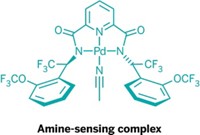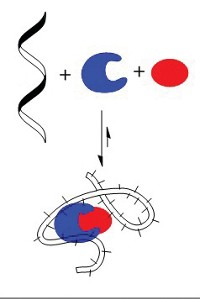Advertisement
Grab your lab coat. Let's get started
Welcome!
Welcome!
Create an account below to get 6 C&EN articles per month, receive newsletters and more - all free.
It seems this is your first time logging in online. Please enter the following information to continue.
As an ACS member you automatically get access to this site. All we need is few more details to create your reading experience.
Not you? Sign in with a different account.
Not you? Sign in with a different account.
ERROR 1
ERROR 1
ERROR 2
ERROR 2
ERROR 2
ERROR 2
ERROR 2
Password and Confirm password must match.
If you have an ACS member number, please enter it here so we can link this account to your membership. (optional)
ERROR 2
ACS values your privacy. By submitting your information, you are gaining access to C&EN and subscribing to our weekly newsletter. We use the information you provide to make your reading experience better, and we will never sell your data to third party members.
Analytical Chemistry
Aptamers For Small Molecules
Biosensors: Strategy for designing custom oligonucleotides could lead to biosensors for small metabolites
by Celia Henry Arnaud
October 6, 2014
| A version of this story appeared in
Volume 92, Issue 40

Aptamers—folded oligonucleotides designed to bind a ligand of interest—are often used to make biosensors. But finding high-affinity, selective aptamers for very small molecules such as simple sugars or amino acids can be tough because such molecules often lack functional groups for the aptamers to grab onto. Researchers at Columbia University have found a way around this problem. The resulting aptamers could be used to make sensitive biosensors that can, for example, detect the low concentrations of glucose found in hypoglycemic individuals.
Researchers typically screen libraries of aptamers to select ones that bind an isolated small molecule. Instead, Milan N. Stojanovic, Tilla S. Worgall, and coworkers select aptamers that recognize complexes of synthetic receptors bound to those molecules (Nat. Chem. 2014, DOI: 10.1038/nchem.2058). In this way, they developed one set of aptamers that differentiates the sugars glucose, fructose, and galactose and another set of aptamers that distinguishes the amino acids phenylalanine, tryptophan, and tyrosine.
To identify the sugar-specific aptamers, they selected nucleic acid sequences that bind complexes of the sugars with a boronic acid-containing receptor. For the amino acids, they used an organometallic rhodium complex as the receptor. “The method is truly general in that almost any organic receptor can have its selectivity and affinity improved,” Stojanovic says.
The sensors could have important clinical applications. The glucose sensor, for example, is suitable for measuring the low glucose levels associated with hypoglycemia. The researchers also used the phenylalanine aptamer to measure the amino acid in human serum. Sensors based on the aptamer could give individuals with the metabolic disorder phenylketonuria a way to monitor their phenylalanine levels.
The researchers are using the method to develop aptamers for other tough-to-distinguish targets, such as lipids. They are also looking for aptamers that can detect the branched-chain amino acids valine, leucine, and isoleucine.
The method “will significantly expand our ability to develop aptamers for diverse small-molecule targets,” says Yingfu Li, an aptamer expert at McMaster University in Hamilton, Ontario.





Join the conversation
Contact the reporter
Submit a Letter to the Editor for publication
Engage with us on Twitter